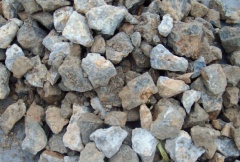Antimony Ore
| Infobox on Antimony Ore | |
|---|---|
| Example of Antimony Ore |  |
| Facts | |
| Origin |
|
| Stowage factor (in m3/t) |
|
| Humidity / moisture | - |
| Ventilation | - |
| Risk factors | See text |
Antimony Ore
Description
Antimony is a silvery-white, shiny element that looks like a metal. It has a scaly surface and is hard and brittle like a non-metal. It can also be prepared as a black powder with a shiny brilliance to it.
The melting point of antimony is 630°C (1,170°F) and its boiling point is 1,635°C (2,980°F). It is a relatively soft material that can be scratched by glass. Its density is 6.68 grams per cubic centimeter.
Antimony is a toxic chemical element with symbol Sb and atomic number 51. A lustrous gray metalloid, it is found in nature mainly as the sulfide mineral stibnite (Sb2S3). Antimony compounds have been known since ancient times and were used for cosmetics; metallic antimony was also known, but it was erroneously identified as lead. It was established to be an element around the 17th century.
For some time, China has been the largest producer of antimony and its compounds. The industrial methods to produce antimony are roasting and subsequent carbothermal reduction or direct reduction of stibnite with iron.
The extraction of antimony from ores depends on the quality of the ore and composition of the ore. Most antimony is mined as the sulfide; lower grade ores are concentrated by froth flotation, while higher grade ores are heated to 500–600°C, the temperature at which stibnite melts and is separated from the gangue minerals. Antimony can be isolated from the crude antimony sulfide by a reduction with scrap iron.
The sulfide is converted to an oxide and advantage is often taken of the volatility of antimony oxide, which is recovered from roasting. This material is often used directly for the main applications, impurities being arsenic and sulfide. Isolating antimony from its oxide is performed by a carbothermal reduction.
Antimony is a moderately active element. It does not combine with oxygen in the air at room temperature. It also does not react with cold water or with most cold acids. It does dissolve in some hot acids, however, and in aqua regia. Aqua regia is a mixture of hydrochloric and nitric acids. It often reacts with materials that do not react with either acid separately.
Antimony forms a highly useful alloy with lead, increasing its hardness and mechanical strength. For most applications involving lead, varying amounts of antimony are used as alloying metal. In lead–acid batteries, this addition improves the charging characteristics and reduces generation of unwanted hydrogen during charging. It is used in antifriction alloys (such as Babbitt metal), in bullets and lead shot, cable sheathing, type metal (for example, for linotype printing machines, solder (some "lead-free" solders contain 5% Sb), in pewter, and in hardening alloys with low tin content in the manufacturing of organ pipes.
Application
The largest applications for metallic antimony are as alloying material for lead and tin and for lead antimony plates in lead-acid batteries. Alloying lead and tin with antimony improves the properties of the alloys which are used in solders, bullets and plain bearings. Antimony compounds are prominent additives for chlorine- and bromine-containing fire retardants found in many commercial and domestic products. An emerging application is the use of antimony in microelectronics.
Shipment/storage
Ore concentrate or residue of the element antimony. A high density lead-grey mineral, subject to black tarnish.
These commodities are shipped under the rules for regulation: antimony compounds, inorganic n.o.s. if shipped in bags, attention must be paid to dust damage. When in moist condition, the cargo may develop toxic gases as stibine, arsine and phosphine (depending on its condition). When shipped in bulk and bags, consideration should be given for not overstressing the maximum permissible tanktop loads.
Precautions should be taken to protect the machinery and accomodation spaces from the dust of the cargo and protective clothing is recommended for persons who may be exposed to the dust of the cargo.
Risk factors
Reference is made to the relevant IMO publications of hazardous cargo.
Antimony and its compounds are dangerous to human health. In low levels, these materials can irritate the eyes and lungs. They may also cause stomach pain, diarrhea, vomiting, and stomach ulcers. At higher doses, antimony and its compounds can cause lung, heart, liver, and kidney damage. At very high doses, they can cause death.











